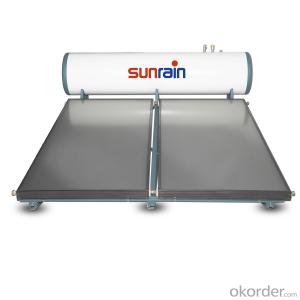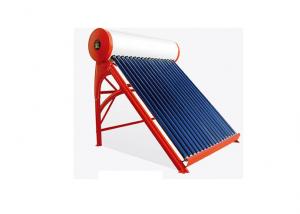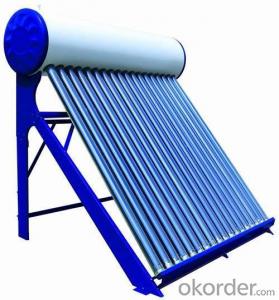RV Compact Non-Pressurized Solar Water Heater System
- Loading Port:
- China main port
- Payment Terms:
- TT OR LC
- Min Order Qty:
- 10 set
- Supply Capability:
- 5000 set/month
OKorder Service Pledge
OKorder Financial Service
You Might Also Like
Working Principle of Domestic Solar Water Heaters:
Solar energy, in essence, is an electromagnetic wave, a type of strong optical radiation, which is produced by thermonuclear fusion reaction. The energy of the solar radiation is transmitted through the liught of different wave length. The solar water heater is designed to mainly take in the energy of visible light & near ultra red light through the selective absorbing coating of vacuum tubes.When the water in the solar collector is heated by the solar radiation, its temperature rises. As a result, the water in the solar collector and the water in the tank form natural convection because of density contrast casued by the temperature difference. So the water of the higher temperature is incessantly forced into the insulated solar water tank( As shown in the figure).
Features
<1> Imported SUS304-2B food-level stainless steel,thickness:0.31~0.5mm
<2> Outer tank: High quality stainless steel,thickness:0.31~0.5mm
<3> Insulation: 50~55mm polyurethane foam
<4> Vacuum tube: CU/SS-AL/N red tube
<5> Frame: Stainless steel/Aluminum alloy,thickness:1.2~2mm
<6> Reflector: Stainless steel/Aluminum alloy as option
<7> Available accessories: Feeding tank,solar controller,electric heater, Mag rod,thermostatic mixing valve
Specification
ITEM.NO | SPECIFICATION | EFFECTIVE LIGHT AREA | TANK'S CAPACITY | APPLICATION PEOPLE | CBM | |||
DIAMETER OF WATER TANK | QTY OF TUBE(pcs) | DIAMETER OF TUBE | LENGTH OF TUBE | |||||
Z-NS5810 | 460mm | 10 | 58mm | 1.8m | 1.04 | 100L | 4 | 0.37 |
Z-NS5812 | 460mm | 12 | 58mm | 1.8m | 1.25 | 120L | 4-5 | 0.44 |
Z-NS5815 | 460mm | 15 | 58mm | 1.8m | 1.56 | 150L | 6 | 0.56 |
Z-NS5818 | 460mm | 18 | 58mm | 1.8m | 1.87 | 180L | 7-8 | 0.64 |
Z-NS5820 | 460mm | 20 | 58mm | 1.8m | 2.08 | 200L | 8 | 0.7 |
Z-NS5825 | 460mm | 25 | 58mm | 1.8m | 2.61 | 250L | 10 | 0.89 |
Z-NS5830 | 460mm | 30 | 58mm | 1.8m | 3.13 | 300L | 12 | 1 |
Z-NS5836 | 460mm | 36 | 58mm | 1.8m | 3.75 | 360L | 14-15 | 1.3 |
Z-NS5840 | 460mm | 40 | 58mm | 1.8m | 4.17 | 400L | 16 | 1.4 |
Z-NS5845 | 460mm | 45 | 58mm | 1.8m | 4.69 | 450L | 18 | 1.6 |
Product Details Show:



FAQ
1. Q: Are you a factory or trading company?
A: We are a factory. Especially for Solar Controller, PWM solar controller 50A12V/24V
2. Q: Where is your factory located? How can I visit there?
A: Our factory is located in Guangzhou, China. You are warmly welcomed to visit us!
3. Q: what other product you have except such Solar Lighting?
A: We have poly ,mono cells and panels. Off grid solar system, like off grid solar inverter, pure sine wave inverter, solar collector, solar controller, solar charger, Portal solar system, battery, DC Fan, Solar Led Light.
4. Q: Can the price be cheaper?
A: Of course, you will be offered a good discount for big amount.
5. How can I get a sample?
A: Please call us or send email for asking the samples.
- Q: Can a solar water heater be used in areas with limited warranty coverage?
- Yes, a solar water heater can be used in areas with limited warranty coverage. However, it is important to consider the potential risks and costs associated with repairs or replacements in such areas. It may be advisable to choose a reliable and durable solar water heater model, ensure proper maintenance, and explore local repair options to mitigate any warranty limitations.
- Q: How does a solar water heater affect carbon footprint?
- Utilizing a solar water heater can make a significant difference in reducing one's carbon footprint. Unlike traditional water heaters that depend on non-renewable sources like gas or electricity generated from fossil fuels, solar water heaters harness the energy from the sun to heat water. This means that they produce absolutely no greenhouse gas emissions while operating, resulting in a substantial decrease in carbon emissions. By harnessing solar energy, a water heater can help alleviate the dependence on fossil fuels for the energy-intensive process of heating water, which accounts for a significant portion of a home's energy consumption (up to 18%, according to the U.S. Department of Energy). This reliance contributes to a substantial carbon footprint. By transitioning to a solar water heater, this energy demand can be met with clean and renewable energy, leading to a noteworthy reduction in carbon emissions. Furthermore, solar water heaters are highly efficient and can provide hot water all year round, even in colder climates. This diminishes the need for backup heating systems, thus further reducing overall energy consumption and carbon emissions associated with water heating. Moreover, the installation of a solar water heater also brings positive effects to local communities and the environment. By encouraging the use of renewable energy, it helps diminish the demand for non-renewable energy sources, consequently reducing the extraction and combustion of fossil fuels. This results in a decline in air and water pollution, as well as the associated adverse health effects. To sum up, a solar water heater effectively reduces one's carbon footprint by utilizing clean and renewable energy for water heating, minimizing reliance on fossil fuels, and decreasing carbon emissions. It presents an efficient and sustainable solution to lessen environmental impact and promote a greener future.
- Q: Is a solar water heater eligible for tax credits?
- Yes, a solar water heater is generally eligible for tax credits.
- Q: Can a solar water heater be used in areas with limited access to energy-efficient appliances?
- Yes, a solar water heater can be used in areas with limited access to energy-efficient appliances. Solar water heaters are designed to utilize sunlight to heat water, reducing the reliance on electricity or gas. They can be a viable option for areas with limited access to energy-efficient appliances as they are cost-effective, environmentally friendly, and can provide hot water even in remote locations.
- Q: How to use solar water heater for temperature sag
- Increase the use of hot water when the number of sunny temperature lower than -5 DEG C, several times a day to use a small amount of solar water heater in the water, but also can effectively prevent outdoor pipeline blockage or cracking. The lower the temperature, the number of hot water to the more frequently, in order to prevent the freezing of water pipes.
- Q: Can a solar water heater be installed in an apartment building?
- Yes, a solar water heater can be installed in an apartment building. However, it may require careful planning and coordination with the building management and residents to determine the feasibility of installation, adequate space availability, and proper maintenance arrangements.
- Q: How does a solar water heater affect water heater maintenance requirements?
- A solar water heater can significantly reduce water heater maintenance requirements. Since solar water heaters use the sun's energy to heat water, they have fewer mechanical components compared to traditional water heaters. This means there are fewer parts that can malfunction or require regular maintenance. Additionally, solar water heaters often have a longer lifespan compared to conventional models, reducing the need for frequent replacements or repairs. Overall, the maintenance requirements for a solar water heater are generally lower, resulting in cost savings and less hassle for homeowners.
- Q: How does the efficiency of a solar water heater compare to a traditional water heating system during off-peak hours?
- During off-peak hours, when there is less demand for hot water, the efficiency of a solar water heater is generally higher compared to a traditional water heating system. This is because solar water heaters utilize sunlight to heat the water, which is a free and renewable energy source, whereas traditional water heating systems often rely on electricity or gas, which may be more expensive and less environmentally friendly. Additionally, solar water heaters are designed to store and retain heat for longer periods, allowing them to efficiently heat water even when the demand is low.
- Q: Can a solar water heater be installed in areas with limited sunlight?
- Yes, a solar water heater can still be installed in areas with limited sunlight. While the efficiency and performance of the solar water heater may be impacted, it can still provide some level of energy savings and hot water. Additionally, incorporating backup heating systems or utilizing hybrid solar water heaters can help mitigate the effects of limited sunlight in such areas.
- Q: Can a solar water heater be used in areas with extreme temperatures?
- Yes, a solar water heater can be used in areas with extreme temperatures. However, the performance of the system may vary depending on the specific conditions. In extremely cold climates, additional insulation and anti-freeze measures may be necessary to prevent freezing of the water and damage to the system. In extremely hot climates, the efficiency of the solar water heater may be higher, but proper ventilation and cooling mechanisms may be required to prevent overheating. Overall, with proper design considerations and adaptations, solar water heaters can effectively function in areas with extreme temperatures.
Send your message to us
RV Compact Non-Pressurized Solar Water Heater System
- Loading Port:
- China main port
- Payment Terms:
- TT OR LC
- Min Order Qty:
- 10 set
- Supply Capability:
- 5000 set/month
OKorder Service Pledge
OKorder Financial Service
Similar products
Hot products
Hot Searches
Related keywords































